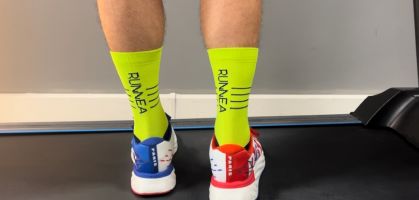Several weeks after the publication of the Runómetro 2019 Report we continue to unpack the data it has provided on the profile and habits of women runners in Spain.
One of the most striking data has been that many women who practice running do it to clear their heads and thus eliminate the symptoms of daily stress. Therefore, this post is aimed at talking about exercise (in our case running) and the positive effect it has to avoid developing anxiety and depression problems, among others.
According to the World Health Organization (WHO), depression is a disease characterized by a negative mood, feelings of guilt, poor sleep or not resting properly, decreased appetite, energy and a long etcetera.
Although the treatment of this symptomatology continues to be pharmacological in many cases, studies have suggested exercise as a good coadjuvant in the treatment of this disease (Möller and Henkel, 2005).

Why running is our best medicine: the release of endorphins!
There is the hypothesis of endorphins which are something we don't know exactly what they are but everyone has heard about them at some point. First of all we are going to consult Andrea Corrales Pardo, doctor in physiology and psychology to explain the relationship between endorphins, exercise and that feeling of wellbeing that invades us after having done a good workout.
What are endorphins?
They are an opioid that we generate during a demanding exercise, a great excitement or when suffering pain. The purpose of this opioid will be to produce a certain analgesia and sense of well-being.
"By this we do not mean that exercising to exhaustion will make you happier, but rather that the secretion of these endorphins will partially alter your mood towards a feeling of pleasure and well-being," says Andrea Corrales. A study conducted with participants in long-distance races (they trained more than 4 hours a week) showed that after finishing the training their mood had improved significantly (Boecker et al., 2008).

One of the possible causes of this feeling of well-being may be a type of endogenous opioid called ?-endorphin whose levels increase during physical exercise, reducing symptoms of anxiety and depression. Therefore, and attending to this hypothesis, it is normal that after performing our daily practice we feel much better. If we add to this the fact that the sensation of pleasure positively reinforces the practice of sports, this translates into an increase in the probability of repeating this behavior in order to seek that pleasurable reward again.
Exercise is considered a polypill due to its wide range of improvements on the physical and psychological health of the person who performs it, but how much do I have to do to get these benefits?
A practice of 3 days per week of aerobic exercise for 8 weeks has been shown to be more effective in reducing depressive symptoms than a single day of exercise (Legrand and Heuze, 2007). In turn, intensity may be key in the release of ?-endorphins, such that at high intensity there is a greater release (Dunn et al., 2002). Therefore, and taking into account this study, we can speak that it would be necessary to take into account both the number of days and the intensity to benefit from the decrease of depressive and anxiety symptoms.
If in addition to taking into account the above mentioned, you go out to train accompanied by other people, the benefits of exercise can increase substantially. "Running with friends not only distracts you from the worries of everyday life, but that support and social interaction makes you release a neurohormone called oxytocin which is able to protect you and reduce some of the negative effects of stress on the body (Uvnas-Moberg and Petersson, 2005), "qualifies this doctor in physiology.
So what are you waiting for, put on your running shoes, call your friends, go for a run and enjoy the practice and the biochemical aftertaste that training and sharing time and the hobby with other people leaves in your body.

Bibliographic references:
- Boecker H, Sprenger T, Spilker ME et al. (2008). The runner's high: opioidergic mechanisms in the human brain. Cereb Cortex 18(11):2523-2531.
- Dunn AL, Trivedi MH, Kampert JB, Clark CG, Chambliss HO. (2002). The DOSE study: a clinical trial to examine ef?cacy and dose response of exercise as treatment for depression. Control Clin Trials 235):584-603.
- Legrand F, Heuze JP (2007). Antidepressant effects associated with different exercise conditions in participants with depression: a pilot study. J Sport Exerc Psychol 293):348-364.
- Möller HJ, Henkel V. (2005). What are the most effective diagnostic and therapeutic strategies for the management of depression in specialist care? Health Evidence Network report. WHO Regional Office for Europe, Copenhagen. http://www.euro.who. int/Document/E86602.pdf, accessed 1/5/09.
- Uvnas-Moberg, Petersson (2005). Oxytocin, a mediator of anti-stress, well-being, social interaction, growth and healing. Psychosom Med Psychother 51(1):57-80.
Read more news about: Running Training





























